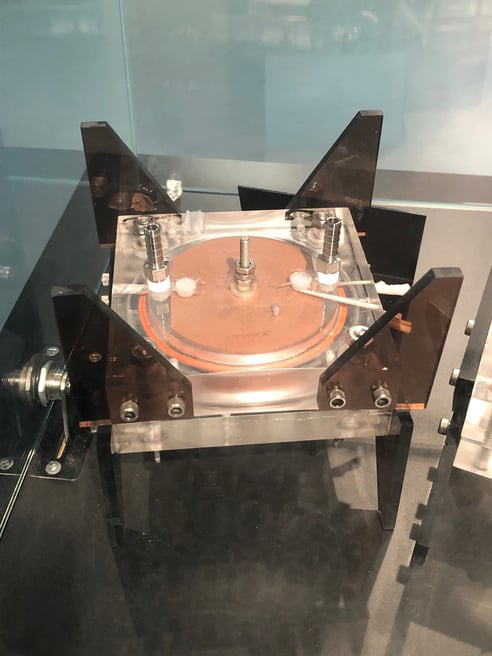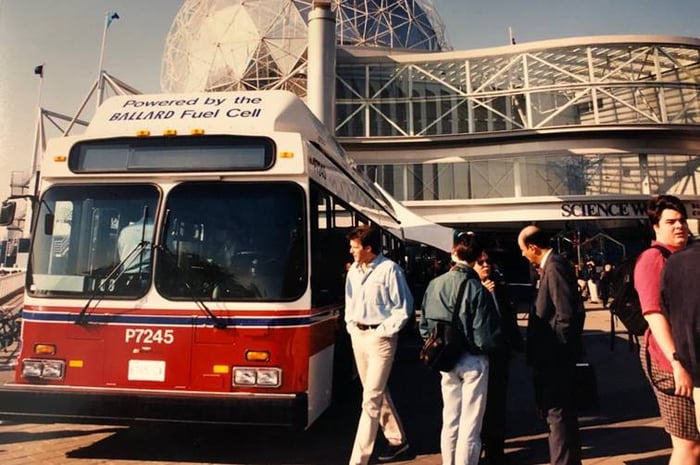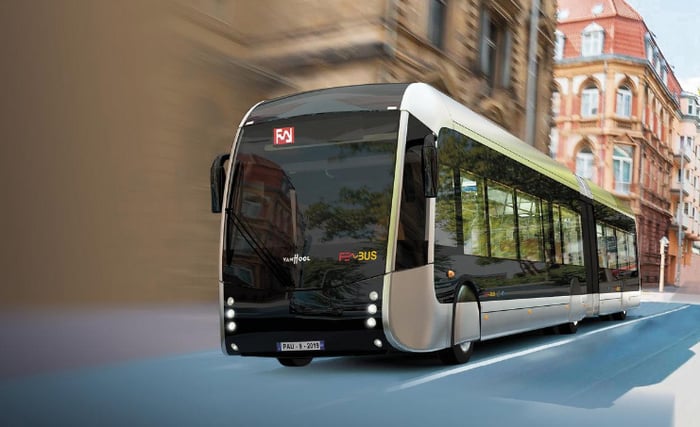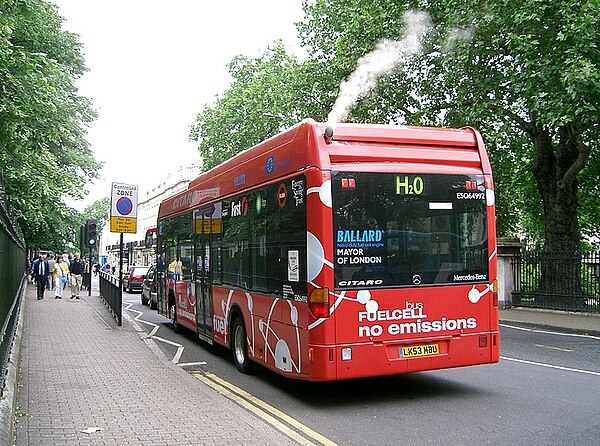This week at Ballard, we’re celebrating our 40th anniversary!
We’re so grateful for the passion and dedication of past and present employees, partners, suppliers, customers, and shareholders who have been at our side on this journey towards a hydrogen society.
Thank you for joining us on our mission to positively influence the next generation through hydrogen and fuel cell technology.
In this week’s article, we put together a special joint-interview with one of Ballard’s three co-founders, Paul Howard, and our current CEO, Randy MacEwen. We asked them about their vision for Ballard, their biggest challenges, the future of the industry, and more.
 Ballard Co-Founder Paul Howard (left) and CEO Randy MacEwen (right)
Ballard Co-Founder Paul Howard (left) and CEO Randy MacEwen (right)
Paul Howard is a founder of Ballard Power Systems where he served as Vice President from its inception in 1979 until 1998.
Mr. Howard’s work with PEM fuel cell technology culminated in 1993 with the highly successful introduction of the world’s first zero emission hydrogen fuel cell powered transit bus.
After leaving Ballard, in 1999, Paul, co-founded General Hydrogen in order to develop complete hydrogen solutions where he served as co-chair until 2007.
Paul received many awards and recognitions during his outstanding career including the Order of British Columbia in 2000.
Randy MacEwen has been the President & CEO and a member of the board of directors of Ballard since 2014. He has held executive roles in clean energy companies for almost 20 years, including in fuel cells and solar.
Q&A with Ballard Co-Founder Paul Howard and President Randy MacEwen
Paul, what was the moment that made you realize fuel cell technology might have commercial applications?
Paul: When we started the company in 1979, we were developing lithium battery technology. Geoffrey Ballard was the visionary, Keith Prater was the scientist and I was the engineer/builder.
Proton Exchange Membrane (PEM) fuel cells were originally developed by General Electric (GE) in the 1960s, for use in the Gemini space mission. But because they were exotic and very expensive to manufacture, they were essentially abandoned after that.
So with our understanding of electrochemistry, and in conjunction with a government program, we decided to revisit PEM technology in 1983.
By 1987, we had significantly improved the power density of the fuel cell because of advancements in engraving technology used to make the flow field plates. These activities would have cost millions of dollars in the 60s.
At the same time, we evaluated a new proton exchange membrane being developed by Dow Chemical. We were rewarded with a ten-fold increase in the power density which essentially meant lower cost. That was when we could see there was potential for PEM technology.
 Ballard’s first hydrogen fuel cell
Ballard’s first hydrogen fuel cell
How we described it was that we had brought PEM technology from outer space into the earth’s orbit.
As a small company, we decided to present our results at a fuel cell conference in Florida. Attendees saw our presentation and asked, “Are those results real?”
Honestly, I think those scientists and engineers were rather skeptical, so we invited them to come to Vancouver see our work for themselves.
And they came. We showed them the laboratory fuel cell and the power density, and they were like 'wow'.
From 1987 to 1990, we had many technical visitors who came to see what we were doing. They’d be scratching their heads saying, “These guys might be onto something with this technology.”
The real beginning happened when we put the PEM technology in a small, completely self-contained unit that delivered about 3 kilowatts, which we showcased at the first ever Globe Conference in Vancouver in 1990.
But Geoffrey Ballard had a bigger vision. He said, "You know, if we want to make this happen, we've got to put the fuel cell in something practical that people can see. We should put this into a bus and show people what it can do.”
So in 1990, Geoff arranged for the $6 million funding and asked me to put together a small team to scale up the fuel cell to 100 kilowatts and install the system in a 30 foot bus.
It was a 3-year program and we were scheduled to demonstrate the bus by June of '93. But by January (of '93), we had an opportunity to do it earlier than planned.
We thought everything was working properly, and so, we said, "Why don't we see if we can actually drive this bus?" There were probably 15 to 20 employees who heard we were going to try to drive the bus. They all scrambled onboard, we backed out of the bay and drove it around the block.

World’s first fuel cell bus presented in 1993 by Ballard in Vancouver, BC
I was super excited. I ran upstairs into the CEO’s office and said, "We got the bus going, come and see it!". He responded in disbelief, "It's not supposed to be ready for another few months."
"No, no, we drove the bus!” he came down, and together with the others already on board, we went around the block one more time. It was quite an exciting revelation.
Randy, what was the moment that made you realize fuel cell technology might have commercial applications?
Randy: One thing that I like to do is track where capital is making investments. If you go back to 1995 when I first got introduced to the hydrogen fuel cell industry, there was a lot of equity and strategic capital flowing into the technology.
I saw Daimler, Ford, General Motors, BP and Shell all making very significant investments in hydrogen or fuel cells. There were a lot of investors moving into names like Ballard and there were a number of initial public offerings (IPOs) at that time.
So, the first time I thought there was a real, viable commercial opportunity was when I saw these flows of capital moving into the hydrogen and fuel cell space.
Paul, what was the original vision for Ballard Power Systems and how has it matured?
Paul: The best way to describe the vision is to use an analogy. When oil was discovered in the 1860s, it really didn't have much use, beyond lighting and heating.
It wasn’t until the 1880s, when Karl Benz developed the first internal combustion engine (ICE) that oil had a real use which, essentially brought about our petroleum-based economy. The ICE was the engine of change.
In the same way, the fuel cell is a new engine of change. So the focus of the vision was not actually the fuel cell, but to bring about the benefits of hydrogen and a hydrogen-based economy.
So that’s still our vision - to make hydrogen practical and useful because of its virtually limitless availability from water and its environmental advantages.
Randy, you took the helm of Ballard in 2014. What was your vision for Ballard and has it stayed true?
Randy: In many ways, the vision today is very similar to when Ballard was founded. It has been an enduring mission. And it's really about addressing the triple threat of climate change, air quality and energy security by decarbonizing and transitioning to a low carbon economy that includes energy and transportation.
And so that vision of using renewable electricity from wind, solar or hydro to generate zero emission hydrogen, and then using that hydrogen in motive and transportation applications has been enduring for some 40 years.
With that said, there have been two changes happening over the last number of years.
One is that when I joined in 2014, there was a very significant emphasis on stationary and backup power. We recognized that the value proposition for PEM fuel cell technology is for start-stop applications and load applications.
So we prioritized the large markets in motive where our technology is best aligned for those value propositions.

Latest generation of fuel cell buses (Van Hool) powered by Ballard fuel cells
The second thing is, within motive, we recognized that, for fuel cell electric vehicles, the value proposition is strongest where you have long range, a need for fast refueling, and heavy payloads.
So while Ballard has been focusing on fuel cell buses for a long time, our emphasis on the medium and heavy duty motive market is relatively recent.
The value proposition for fuel cells is strongest there, but these are also applications where we have the opportunity for centralized hydrogen refueling. So the barrier to entry is lower there.
Paul, in the context of getting the technology off the ground, what were some of the biggest challenges in the first 10 years?
Paul: The real challenge was to get people to believe in hydrogen and fuel cells. We had senior executives from virtually every major automotive company in the world come to Vancouver to ride on our fuel cell bus.
The response was the same each and every time: "Why aren't we doing this? This thing works! And there's no pollution, only clean water vapour from the exhaust!”
We educated virtually every executive or senior decision-making person involved in the automotive sector. So our challenge was to get them to accept PEM fuel cell technology, and that it really could be used in automotive applications.
Randy, what has been your biggest challenge since arriving at Ballard, and how have you addressed it?
Randy: One challenge, not just for us, but for the industry in general, and in the last two years in particular, is keeping up with the speed of change. It's a very dynamic market.
Globally, we see a number of activities and developments occurring in the industry. To have a company operating at the speed of change has been the largest challenge.
So I’ve addressed this challenge in a couple of ways. One is recognizing that we need to have a culture that has both the clock-speed and the agility that reflects market circumstances. And in some cases, frankly, making sure we have the right risk tolerance.
I would say for a company of our size, for the industry we're in, and for the relative level of immaturity of the industry, Ballard's been a very conservative company. Which is surprising to people when you look at the risk the company's had over the last four years.
So what we've been trying to do is to make sure our risk tolerance is commensurate with the opportunity and the speed that we need to move at.
But we also need to make sure we have, at the same time, the right governance structure to mitigate risk. So it's okay for us to make small mistakes. We can't afford to make big mistakes.
One of the other things that's related to that is, we've significantly strengthened our balance sheet. So that gives us a lot of flexibility as we look at pursuing opportunities, but also gives us flexibility when dealing with those small mistakes.
What do you say to the people who doubt the future of the technology, today?
Paul: It takes time for new technologies to really manifest themselves into practical use. Again I’ll use an analogy: this time, the computer.
IBM developed the mainframe computer in the 1950s. By the 1990s, we saw the advent of the personal computer, with costs that were starting to get to the point of wide market adoption.
But there was never really an understanding of why someone would want a computer until the Internet came along. Essentially, it took five to six decades before the computer was useful and at an affordable price.
I'm not saying hydrogen is going to be the Internet, but the fuel cell is extremely important. So, I say to the doubters, new technologies take time to be fully commercialized we need the benefits of hydrogen.
For humankind to survive, we need hydrogen, which is essentially offers us a limitless source of energy and is environmentally benign.
Randy: There have been skeptics, critics and naysayers for 40 years. And all along, Ballard has pointed to the same vision and market opportunity, and substantively endured.
What's changed today is the ability to point to numbers —actual technology and products operating in the field. So we see over 25,000 fuel cell forklifts, over 11,000 fuel cell cars, and for Ballard, over 2,000 fuel cell buses and commercial trucks all operating in the field.

Ballard powered fuel cell bus on the streets of London
Two or three years ago, those numbers would have been nominal. So for the first time, we can point to real market adoption happening.
The technology has been validated. We've seen dramatic cost reduction on the technology and product front.
The next leg of cost reduction will continue to include improvements—design improvements, product development improvements, and technology improvements, but will also include the benefits of scaling and supply chain.
So to those skeptics and critics, I would just point to the numbers and say, this is happening.

Fuel cell vehicle being refueled with hydrogen
Just look at the number of hydrogen fueling stations. Today in Japan there's about 93 fueling stations. In Germany, there's 69. In California, there's almost 50. Again, if you step back two or three years ago, those numbers were minimal.
Now that you have the ability to look back, what was your biggest achievement?
Paul: My best achievement was getting the fuel cell electric bus out the door of the garage that first time. It was the beginning of the technology being deployed in a real life situation.
I had the good fortune to be surrounded by a great group of people that were passionate and bright, and knew how to get things done. So that was certainly the biggest technical achievement.
From a business achievement perspective, our biggest success was helping to educate people and have them understand the potential of fuel cell technology.
Randy: Actually, our biggest achievements haven't happened yet! But we have a lot of opportunity. Our core competencies and our technology are applicable across a number of end markets and applications.
If you look at heavy duty motive, bus, commercial truck, rail, or marine, they're all large, attractive, addressable markets.

Zero-emission fuel cell trucks in China powered by Ballard technology
So I would say our greatest accomplishment in the past five years has been securing Weichai as a joint venture and strategic partner for the important China market. But in my opinion, our key milestones and successes are ahead of us.
What developments are you expecting in the industry in the next five years?
Paul: I see continual cost reduction related to both the fuel cell engine itself and to hydrogen storage technology. Both of these are very exciting to watch develop. I don't see any reason for these advancements not to achieve full scale market adoption.
Randy: The transformation that's occurring, in my opinion, is unprecedented. I compare the future of mobility to the situation 100 years ago where we transitioned from horse and buggy to the internal combustion engine and cars. That's the type of transition we're looking at in the second great inflection point for mobility.
Change is now driven by four key drivers: autonomy, connectivity, electrification and shared mobility, also known as the ACES trends. And these trends are all converging together to create an environment in the future where, instead of owning a vehicle, the next generation, uses transportation or mobility as a service.
When you think about that paradigm, the utilization of vehicles is going to increase significantly. So rather than a vehicle being used, for one hour a day - 1.55 passengers for five seats for a total utilization of 1.3% - you're looking at vehicles being used 23 hours a day.
That high utilization drives you to a power train technology that offers long range and offers fast refueling. So I think there's a dramatic transition that's occurring in mobility around these ACES trends.
So I believe as we look out to 2030 and 2050 and even to the end of the century, we're going to see a very high penetration of renewables. Today, renewables are about 30% of global electricity production. By 2050, it will be 50%, and by the end of the century it will be 75-100%.
As we move into intermittent renewables, we’ll need an effective storage medium to enable the grids to take on high adoption and penetration of these resources.
So I believe the penetration of renewables, coupled with the transformation of mobility, all lead to zero emission hydrogen fuel cells. That doesn't mean there won't be other technologies. Batteries have a sweet spot for sure. And there will be multiple powertrain winners.
But I believe fuel cells in particular will have high penetration in the use-cases we talked about earlier: long range, fast refueling, heavy payload and route flexibility.
As we wrap up, is there anything else you’d like to share with our readers?
Paul: I have such tremendous respect for Geoffrey Ballard who was my mentor, and over the years we became very close friends.
The three founders of Ballard had complementary skill sets. Keith understood the science of electrochemistry. I had a mechanical engineering background and could build things. Geoff was extremely bright, wise and could assist each of us, but ultimately, he was the visionary.
Geoff chose to make us three equal partners in the company. He had the wisdom to understand that was the best way to do things, to eliminate the potential for friction.
This atmosphere of trust became the foundation of the company. People stuck with us because they were loyal and believed we could make a difference.
Working at Ballard was a wonderful experience. I loved coming to work every day because it was exciting technology.
I’m very proud to be associated with developing this technology and believe we have created a culture that reflected that passion and respect. That culture remains core to the business today.
Randy: Something that's really important to me is, I wake up every morning very excited about the opportunity for decarbonizing energy and transportation.
I want to hand a decarbonized environment to the next generation, where air quality is appropriate, people can have good health, and some of the challenges that come with climate change are vastly mitigated.
But I also wake up every morning very excited about the Ballard organization. And I can say this very humbly: Ballard is uniquely positioned in the fuel cell industry.
Today, we have over 700 employees. A number of employees have been here a very long time, for 15, 20, 25+ years.
Our unique group collectively has about 2,500 years of PEM fuel cell experience. The breadth and depth of technology experience we have is very unique in the industry. And I believe we have a lot of embedded value that hasn't been expressed yet.
There are a number of untapped opportunities in our industry, whether it's the eventual emergence of the passenger car market in high volume, stationary power applications, UAVs and drones, or ultimately flying taxis and other aerospace applications that hydrogen can enable.
Ballard was the first ever company to really demonstrate fuel cell engines in buses.
And actually, this year, Ballard and partners came together and were able to offer a fuel cell electric bus effectively at parity with battery electric buses.
And so I think the vision of using city buses as one of the first applications for adoption was actually very prescient back then, and it's proven to be validated in heavy and medium duty motives over time. So I think the prioritization of the bus market was a very wise choice.
Over to you…
Where do you see Ballard in the next 40 years? What are your hopes for the hydrogen and fuel cell industry? Let us know in the comments below.


